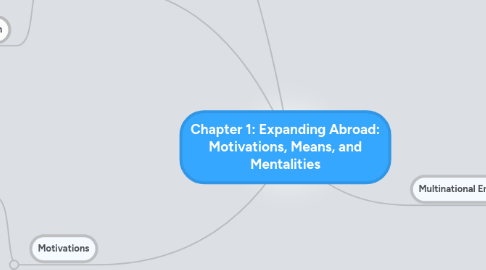
1. Motivations
1.1. Traditional
1.1.1. Secure Key Supplies
1.1.2. Market-seeking behavior
1.1.3. Access low-cost factors of production
1.1.3.1. Cheap labor
1.1.3.2. Lower-cost capital
1.1.4. Captured in the product cycle theory
1.1.4.1. 1. Company has innovation in its home country
1.1.4.2. 2. Production becomes more stabilized, production is set up in foreign markets
1.1.4.3. 3. Product is highly standardized, cost competition -> resource seeking motive
1.1.4.4. Not applicable anymore!
1.2. Emerging
1.2.1. Scale economics, ballooning R&D, shortening product life cycles
1.2.2. Scanning and learning capability
1.2.3. Competitive positioning
2. Means
2.1. Prerequisites
2.1.1. Domestic companies have a home advantage over foreigners because of greater familiarity with the market
2.1.1.1. MNE needs some distinctive competency to overcome the disadvantage of being foreign
2.1.2. MNE must be able to use its assets more effectively through its own subsidiaries than through contractual relations with others
2.2. Process of Internationalization
2.2.1. Incremental
2.2.1.1. Uppsala Model
2.2.1.1.1. Market Commitment
2.2.2. Radical
2.2.2.1. Invest in or acquire local partners directly
2.2.3. Born Global
3. Mentality
3.1. International
3.2. Multinational
3.3. Global
3.4. Transnational
4. Multinational Enterprise
4.1. Definition
4.1.1. Multinational Enterprise (MNE)
4.1.1.1. Has substantial direct investment into a foreign country
4.1.1.2. Actively manages these offshore assets
4.1.2. "International" Enterprise
4.1.2.1. Considers itself international but is not an MNE
4.1.2.2. Sources from overseas, exports products or even has minor equity shares in overseas companies - does not actively manage though!
4.2. Scope
4.2.1. Both strategic and organizational integration
4.2.2. Active, coordinated management of operations in different countries

